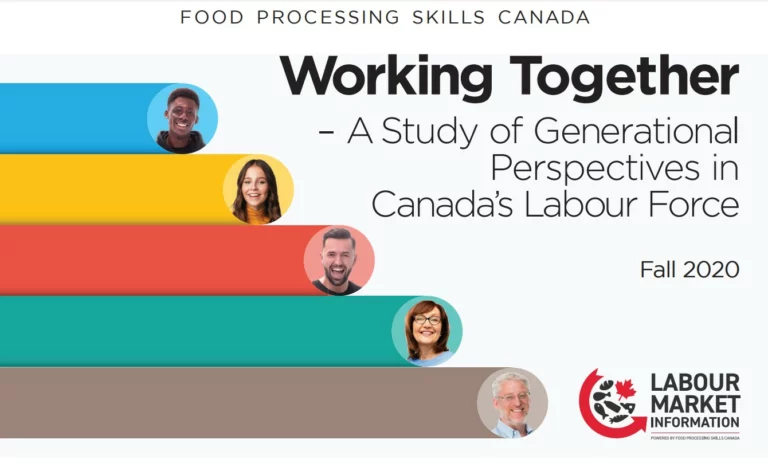
"Every generation imagines itself to be more intelligent than the one that went before it, and wiser than the one that comes after it."
George Orwell
This research was commissioned by Food Processing Skills Canada (FPSC) to examine generational perspectives in the workplace. While some of the survey questions focused on the food and beverage processing sector, the research results and the conclusions and recommendations that flow from them, are relevant to the economy as a whole. The study recommendations are presented in the last chapter of this report.
The research was inspired by certain trends and realities facing the food and beverage manufacturing sector. The following trends are also common to manufacturing generally, as well as to most other sectors of the economy.
The purpose of this report is to raise consciousness by providing Canadian companies and other industry stakeholders with insights into how Canadians in general, and different generations in particular, think about work in 2020 (pre-pandemic).
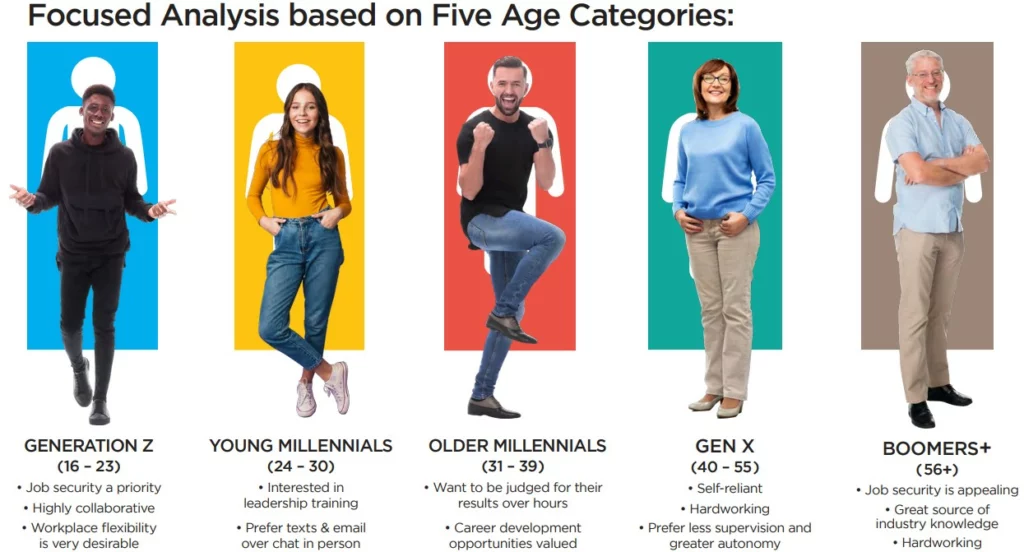
Beginning in the early part of the century, and still today, journalists and consultants have written in earnest about the intergenerational dynamics of the workplace. Exhortations usually revolved around the need for employers to recognize and adapt to the fact that four (and increasingly five) generations are working side-by-side. This passage is typical:
Around the world and across industries, more generations than ever before are working together. Increasingly, it’s younger employees who are leading older team members, turning the established order on its head. This new scenario can cause problems, but it also presents opportunities for sharing knowledge and experience.3
More recently, several academics have challenged the notion that generations of workers differ that much. Writing in the Harvard Business Review in 2019, Eden King et al. point to a meta-analysis of 20 different studies of generational differences which concluded that the relationships between generational membership and work-related outcomes (i.e., job satisfaction, organizational commitment, and intent to turnover) are moderate to small.4
Are workplace intergenerational differences more myth than reality? And how much should employers concern themselves with this? The answer largely depends on the questions being asked. The research was designed to be wide-ranging and went into depth on several issues. As a result, there are quite a few significant differences, particularly in the way members of Generation Z (16 to 23 years of age) look at the world of work. Notable findings from the survey are as follows:
The sample was randomly selected from Leger Opinion (LEO)’s panel of survey respondents. Quotas were used to ensure that the sample reflected the Canadian labour force according to age and region. The data was also weighted to reflect labour force composition by age and region.7 An associated margin of error for a probabilitybased sample of n=1,500 is ±2.5%, 19 times out of 20.
The survey was administered online between March 27th and April 3rd, 2020; the early stage of the COVID-19 pandemic. The World Health Organization (WHO) declared the existence of a global pandemic on March 11th, on March 24th, Canada’s Parliament discussed Bill C-13, the COVID-19 Emergency Response Act. The unemployment figures for the month of March were that the economy had shed 1,000,000 jobs, pushing the official jobless rate to 7.8 percent, and, on April 2nd, Prime Minister Justin Trudeau said that he foresaw the expiry of the COVID-19 crisis to occur in July. This timeline suggests that at the time of data collection, the COVID-19 pandemic had begun to impact the labour market and society, but not to the extent that it would have had much of an effect in the way in which respondents were viewing the world of work and the labour market. Therefore, we consider this survey to be “pre-pandemic”.
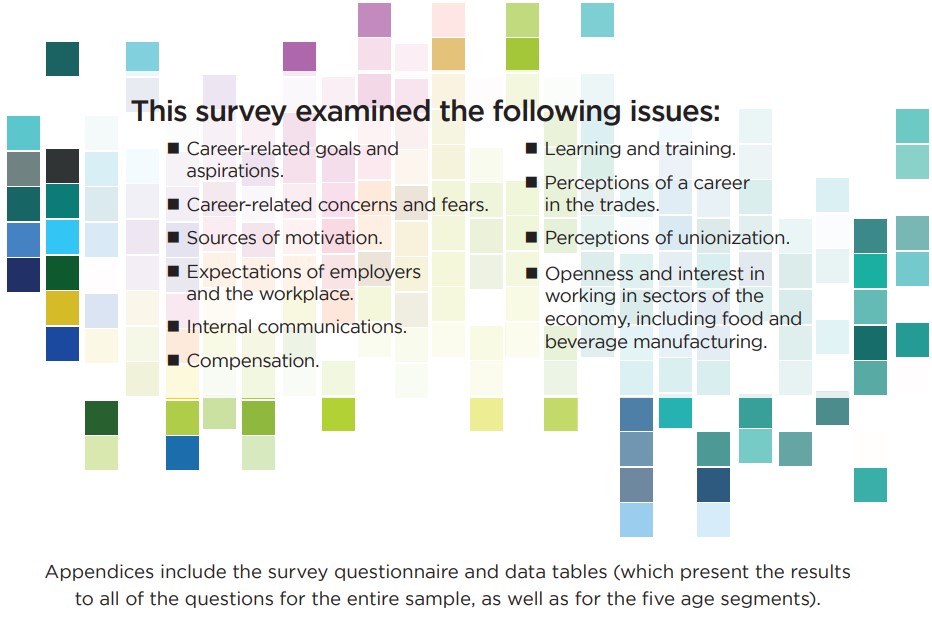
The survey began with a question on career goals and aspirations. Looking at the overall sample, four career goals (from a list of 12) surface as the most important. As could be expected, achieving financial security is at the top of the list, rated important by almost everyone (92%). In addition, Canadians are looking to achieve work-life balance (89%), continuously learn new things (86%) and do work they are passionate about (83%).
There are several generational differences in the importance placed on various career goals. Overall, the older one is, the more modest their expectations are. In terms of specifics, goals such as helping to solve social and/or environmental challenges and doing work they are passionate about are significantly more important to Generation Z.
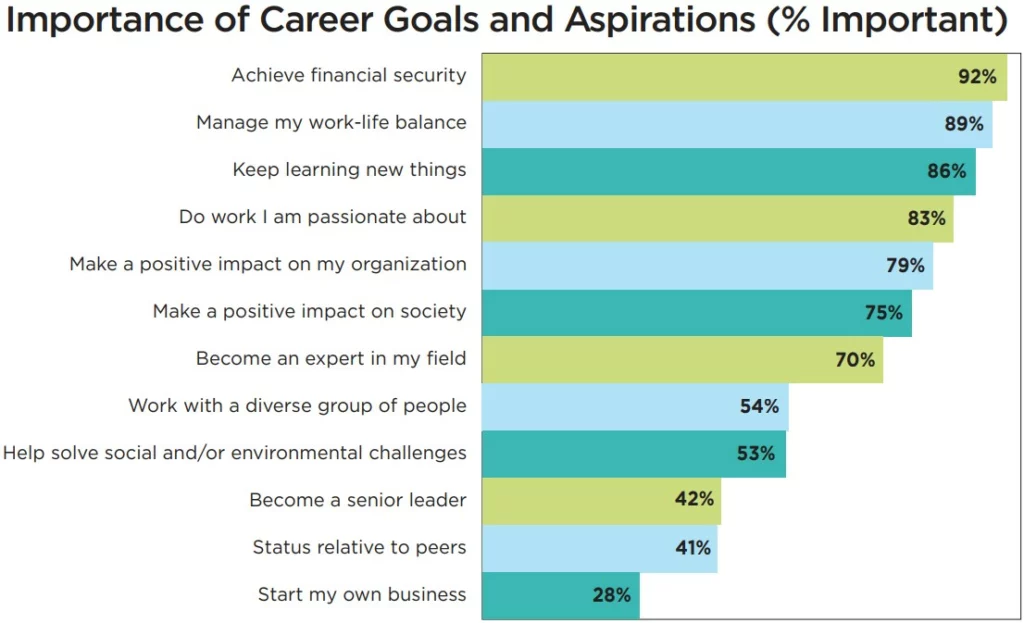
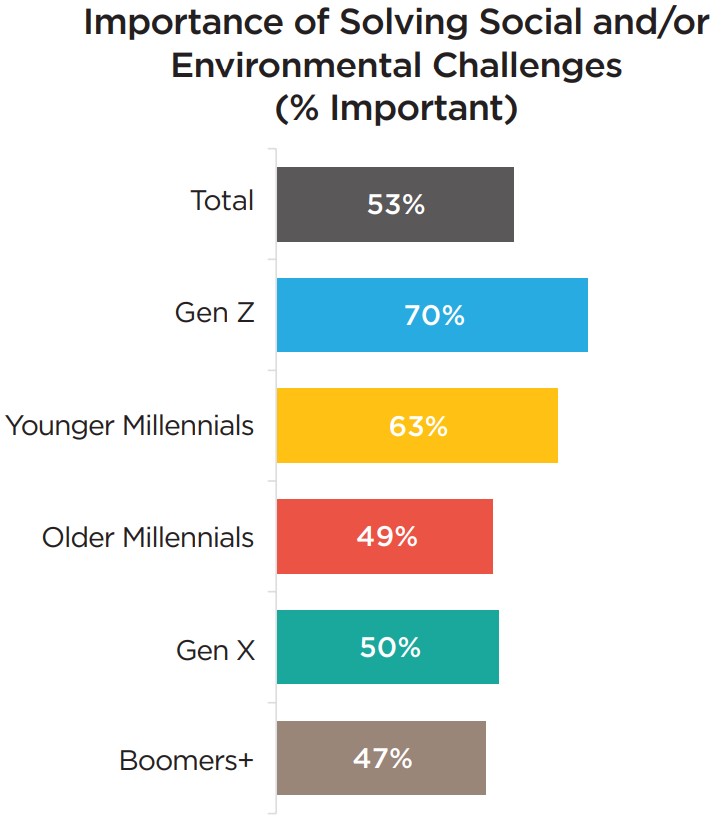
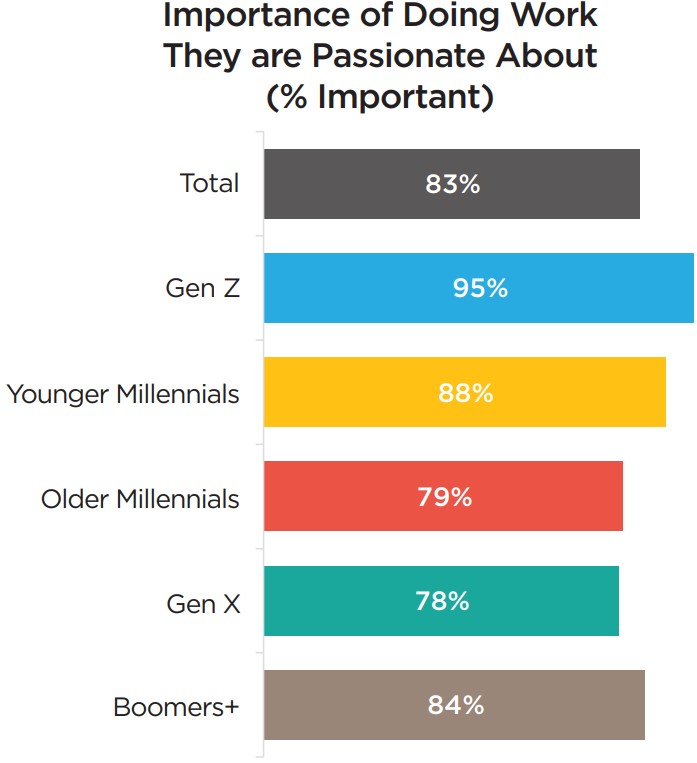
Q: First, for you personally, how important are each of the following career goals? Base: All Respondents, n=1,500
As one moves up the age ladder to young millennial, they are most likely to place extreme importance (i.e., rated 5 out of 5) on career advancement. That is, becoming: an expert in their field (47% compared to a workforce average of 32%), and a senior leader (52% compared to 42% overall). This segment is also keenest about continuously learning new things (63% compared to a workforce average of 50% who rate this goal 5 out of 5).
Employees need motivation to feel good about their jobs and perform optimally. Some employees tend to be intrinsically motivated, while others are extrinsically so. Intrinsic motivation involves doing something because it’s personally rewarding. Extrinsic motivation involves doing something because in pursuit of a reward or to avoid punishment.
Several survey questions were aimed at helping employers understanding what motivates employees (and prospective employees).
First, most Canadians (58%), and Boomers in particular (70%), say that they “love” their job, while only 24% of the sample agree that work for them is only about a paycheck. This tells us that it is realistic for employers to aim high in the quality of relationships they develop with their workforce.
Several survey results show that Canadians hope to derive quite a lot from their job, beyond money and benefits. For example, 69% say it’s important that the organization they work for shares their values. This result highlights the need for employers to identify a coherent set of values and to demonstrate them to employees; workers must be able to discern an organization’s values before they can determine how these may be aligned with their own. Most respondents (74%) also want to feel proud of the organization they work for. There is consistency in views across all five of our age segments on both these measures.
The social dimension of work is important to a significant proportion of Canadians. Many (61%) believe that work should be “fun” most of the time, while half expect to make friends at work. The importance of work as a source of friends is significantly more important to Generation Z (64%).

Q. Please indicate whether you agree or disagree with each of the following statements: Base: All Respondents, n=1,500
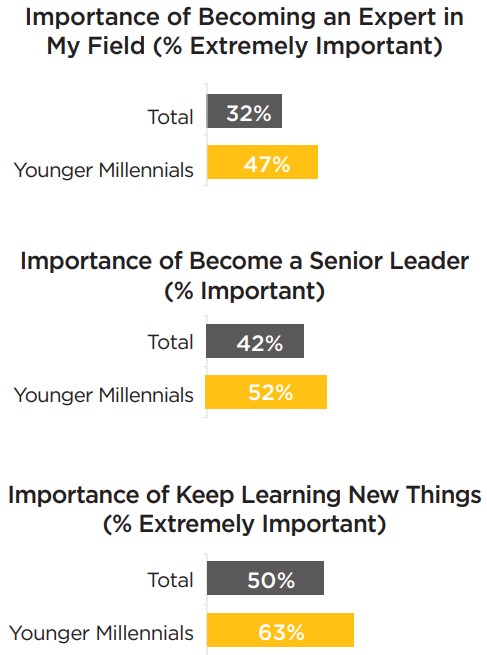
Q. Please indicate whether you agree or disagree with each of the following statements: Base: All Respondents, n=1,500
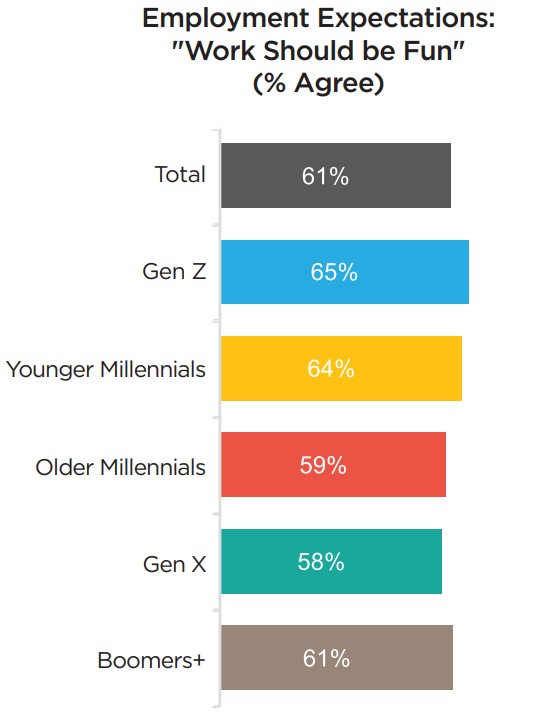
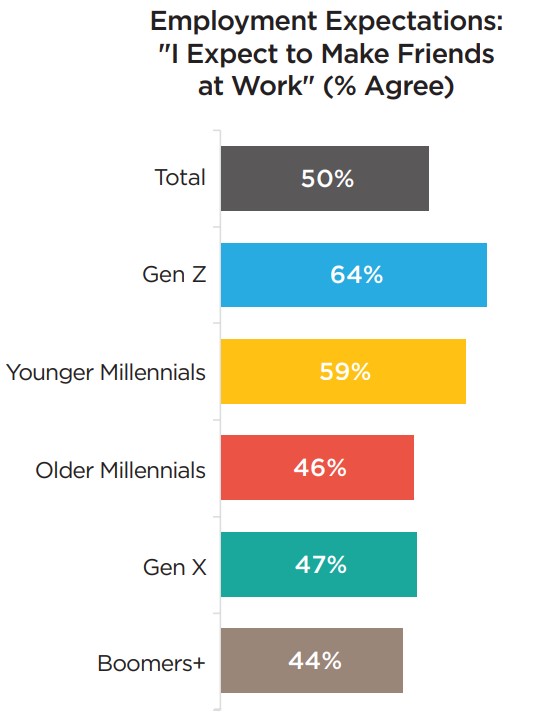
Q: First, for you personally, how important are each of the following career goals? Base: All Respondents, n=1,500
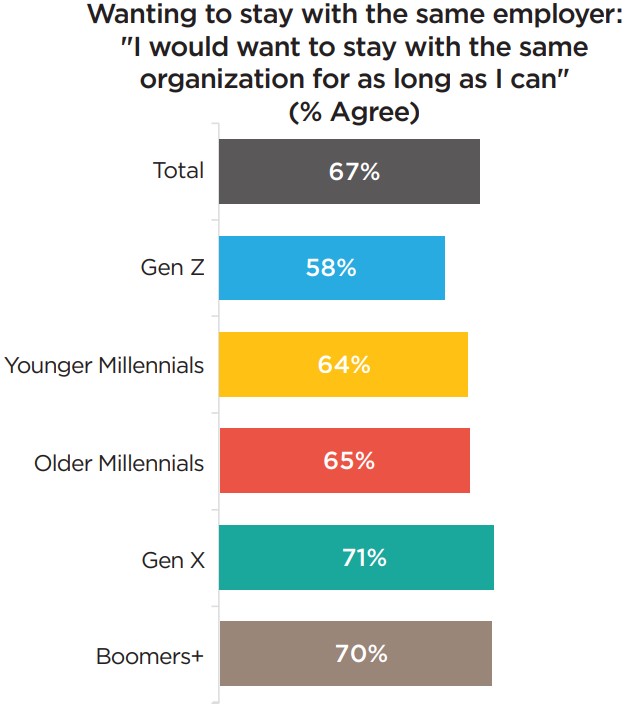
Q: Please indicate whether you agree or disagree with each of the following statements: Base: All Respondents, n=1,500
It is a popular notion that Canadians entering the workforce today can expect to change employers many more times than their parents and grandparents did. Research conducted by Washington, D.C.- based Pew Research Center in 2016, however, casts some doubt on this perceived wisdom. It found that the median job tenure for all U.S. workers was 4.6 years in 2014, up from 3.5 years in 1983.8 This and other statistics beg a fundamental question for employers: Do workers, particularly younger ones, want to change employers relatively frequently, or would they prefer longer-term tenure?
The study finds that most Canadians (67%) want to stay with the same employers as long as they can. More interestingly, perhaps, is that views on this question are uniform across the five age groups
Consistent with the above results pertaining to career goals, the most common sources of worry, from a list of nine, revolve around finances (i.e., being able to enjoy retirement and making enough money) and work-life balance (i.e., balancing work and a healthy lifestyle).
Workplace harassment is last on the list, but it is nevertheless noteworthy, and troubling, that it is a source of worry for fully one-third of the labour force (there are no gender differences in response to this question).
Among the five age segments, this study finds that Boomers are least worried about most issues examined in the survey, including making enough money, career advancement, achieving worklife balance, making friends and fitting in, being overworked, and raising children while working. That Boomers tend to be much less worried than everyone else may not be surprising given that many find themselves towards the end of their working lives.
Once again, the relative importance of workplace social dynamics and social life to the younger segments of the labour market. Most Generation Z (60%) express worry about fitting in and making friends at work, as do 54% of Young Millennials.
Most Generation Z (60%) express worry about fitting in and making friends at work, as do 54% of Young Millennials.
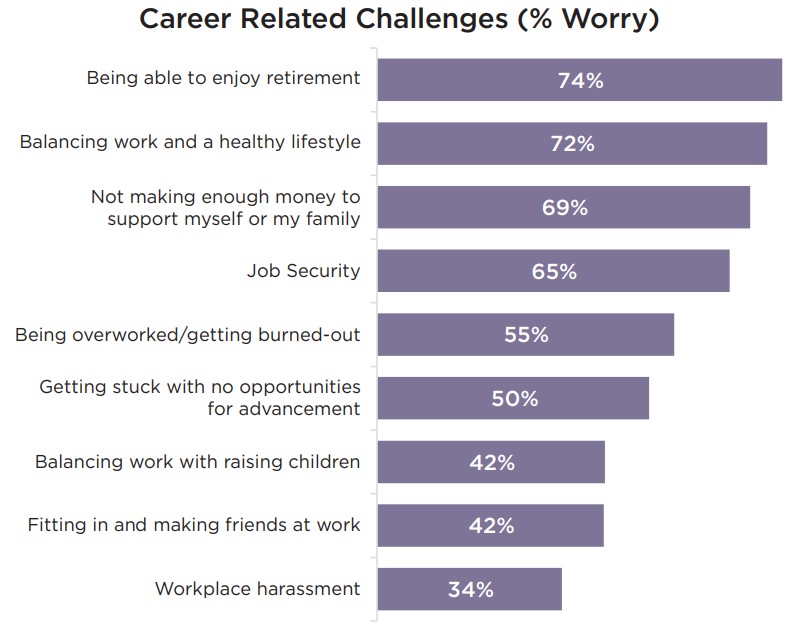
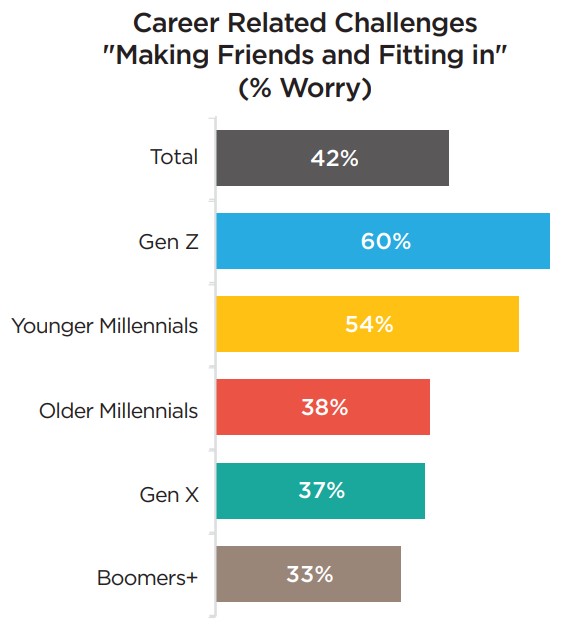
Q: How much, if at all, do you worry about each of the following career-related challenges? Base: All Respondents, n=1,500
The survey asked Canadians about the qualities they wished to see in their immediate supervisor, their organization’s leader, as well as reflected in themselves. Generally, generations value a common set of traits, with one noteworthy difference: Younger people place less importance on honesty.
With respect to one’s immediate supervisor, Canadians place the greatest value on qualities of honesty, fairness, and openness/transparency. The generational differences are interesting. While fairness and openness/transparency are also among the top three most frequently selected qualities by Generation Z, this segment includes “friendliness” on their list. In contrast, honesty is relatively less important to them (in sharp contrast to Boomers). Generation Z is also much more likely than others, particularly Boomers, to want a supervisor who is hardworking.
Top Qualities that are desired by Canadians in Today’s Workplace
Base: All Respondents, n=1,500
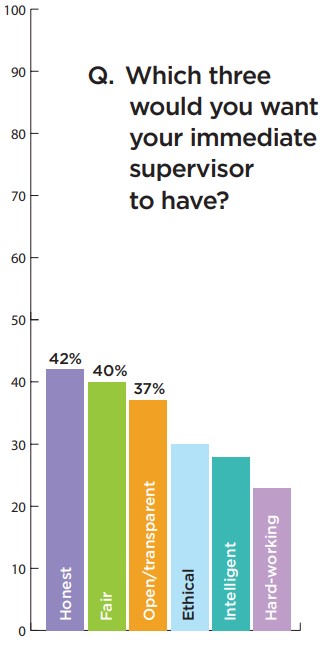
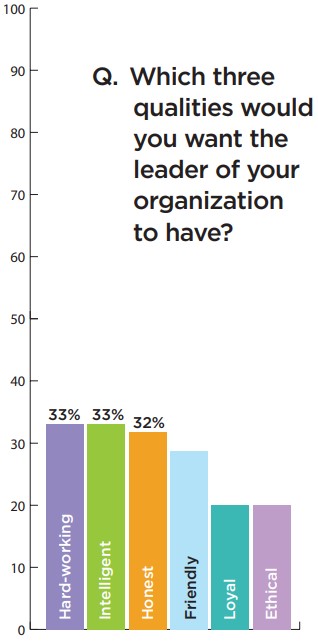
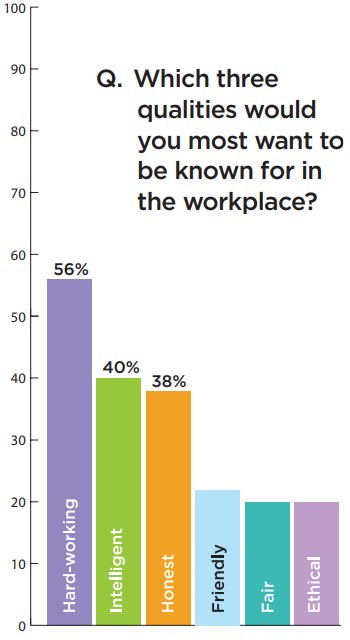
Q. Which three qualities would you want your Immediate Supervisor to have?

Honesty and openness/transparency are among the top three qualities Canadians want to see in their organization’s leader, along with “ethical”, followed closely by “fair and visionary”. The only difference in how generations view this question is the higher importance that Boomers place on honesty.
In the workplace, Canadians want to be seen as: hard-working (selected by 56%), intelligence (40%) and honesty (38%). Once again, the clash between older and younger generations on the salience of honesty, with Gen X (46%) and Boomers (49%) placing much more emphasis on this quality than Young Millennials (24%) and Generation Z (22%) do.
Q. Which three qualities would you want the leader of your organization to have?
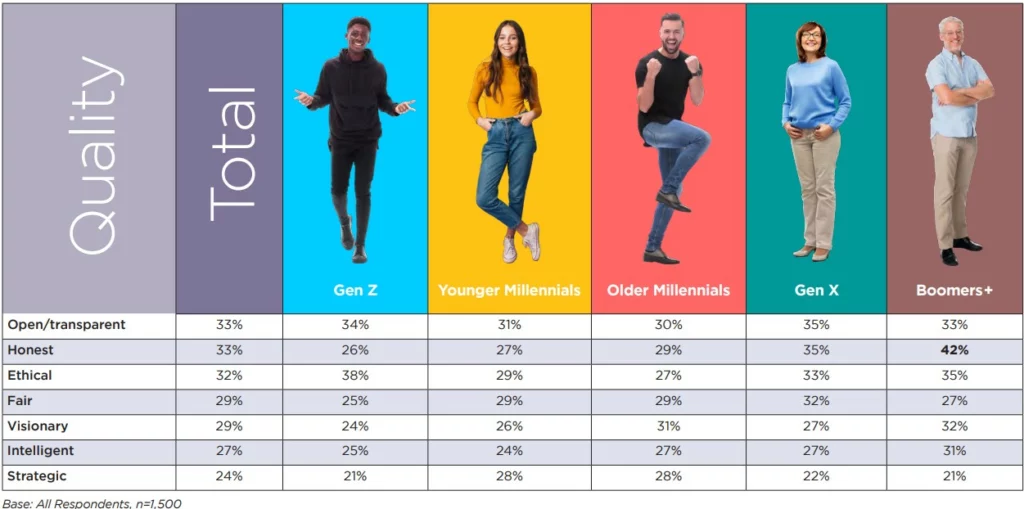
Q. Which three qualities would you most want to be known for in the workplace?
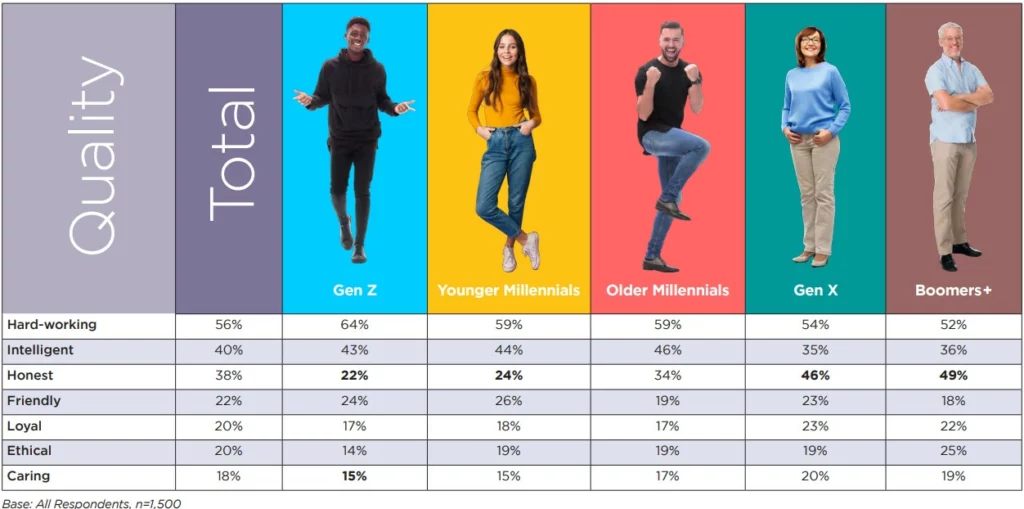
To this point, several differences in views amongst generations has been discussed, particularly between Boomers and Generation Z (and to a lesser extent Young Millennials). Several questions were specifically designed to assess perceptual cleavages in how generations view each other, based on common workplace stereotypes.
Overall, Canadians are more likely to agree than disagree that “most young workers have unrealistic expectations” about advancement (49% to 16%). The older one is, the more likely they are to agree, while Gen X members are evenly split.
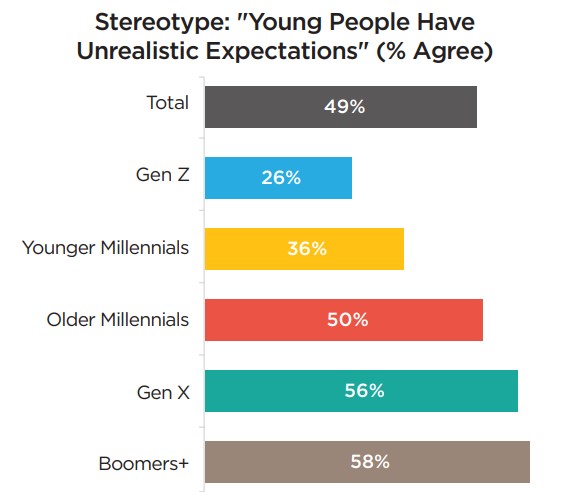
Q: Please indicate whether you agree or disagree with each of the following statements: Base: All Respondents, n=1,500
When it comes to older workers, a strong plurality of those surveyed (47%) agrees that “older workers resist change” (only 18% disagree). The Boomer segment is the only cohort within which there is not majority agreement with this view (33% compared to 36% who disagree).
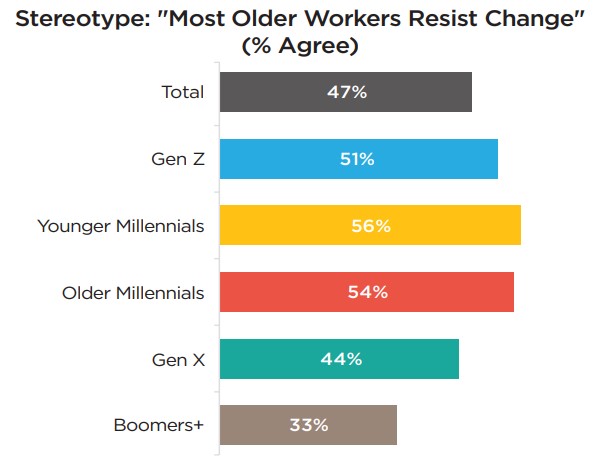
Q: Please indicate whether you agree or disagree with each of the following statements: Base: All Respondents, n=1,500
The etiquette surrounding the use of the phone has long been a source of generational tension. Today, many workers communicate with colleagues and clients primarily on their phones, while in some workplaces personal phones are not allowed. This survey asked whether employees should be able to “check their phone whenever they want”? This is a communications issue, as well as an indicator of generational differences.
Overall, there is no consensus in response to the question, with 50% saying no and 21% agreeing that employees should be able to look at their phones anytime. The least opposed to allowing workers to look at their phones anytime are Young Millennials (33% disagree), while the most opposed are Boomers (68% disagree). The quality of employee-supervisor relationships is key to productivity, organizational morale, and employee retention. As indicated in the introduction to this report, some observers have argued that the presence of a large age gap between workers and supervisors creates several challenges. The results of this study suggest that the age of an immediate supervisor is not a concern for the vast majority of the labour force.
Overall, 19% say that they would not want to work for a younger boss, with Boomers being least sensitive (11%). When it comes to having a boss “from an older generation”, only 10% overall would not like it. Again, the least sensitive are Boomers (only 5% say they would not want a boss from an older generation).
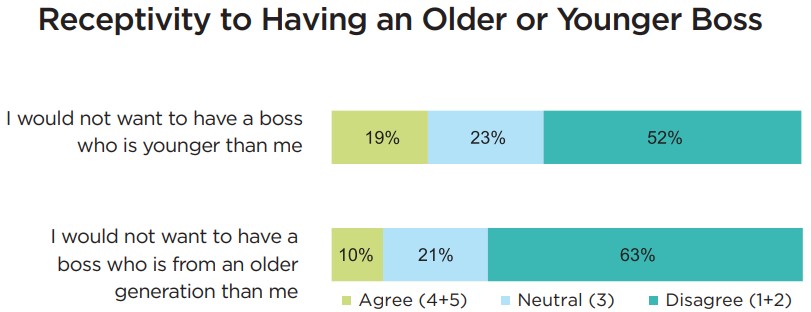
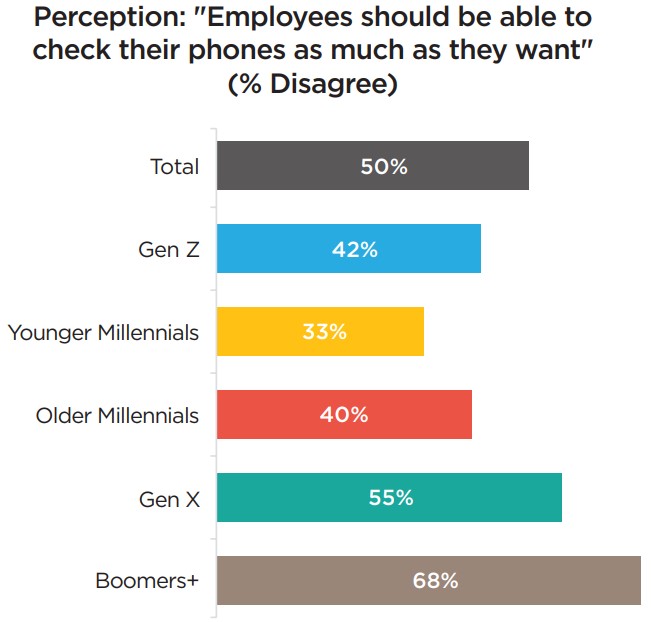
Q. Please indicate whether you agree or disagree with each of the following statements: Base: All Respondents, n=1,500
Boomers are the least sensitive to not wanting to work for a boss from an older generation, at only 5%.
Several survey questions were designed to help employers improve their internal communications. Below, worker preferences with respect to channels, content, and frequency of feedback are examined.
Preferred modes of information sharing vary according to age, but perhaps not as much as one might have expected.
Overall, communicating face-to-face (selected as preferred by 42%) and by email (40%) are the preferred methods for sharing information. Sharing information by text is the top choice of only 5% overall, but it is preferred by a sizable proportion of Generation Z (17% compared to 1% of Boomers).
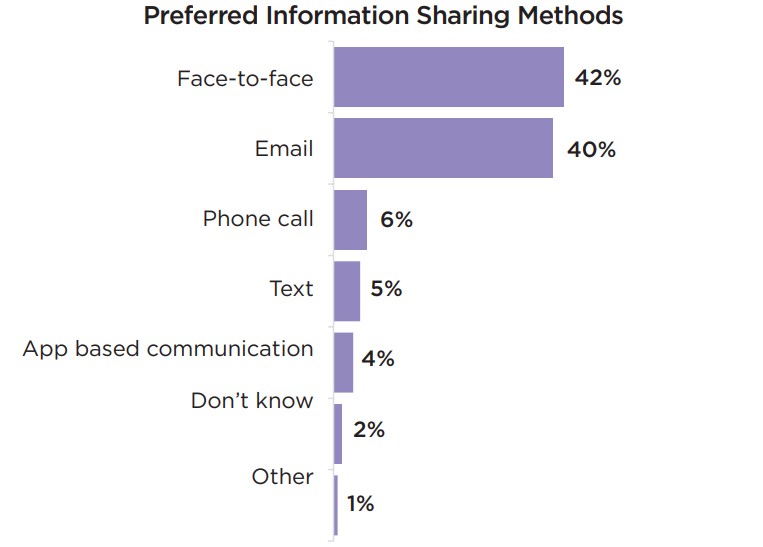
Q: When it comes to sharing information in the workplace, what is your preferred method? Base: All Respondents, n=1,500
"Poor internal communication can have some seriously negative impacts on a company — poor morale, high employee turnover and lower employee productivity, to name a few. Worse yet, these can lead to a lasting effect on a company’s bottom line."
Sara Jensen, Workforce.com (May 2019)
Providing employees with an optimal amount of information is difficult. Most organizations recognize the importance of transparency and of sharing some aspects of the “big picture” with all employees (e.g., business plans, strategic direction, corporate performance). The challenge lies in not overwhelming employees with corporate information.
In examining this issue, this study finds that workers, regardless of age, want to know about their organization’s plans and objectives. Indeed, only 4% do not. Similarly, but less pronounced, just 1 in 3 members of the labour force only want to know about things that directly affect their job. Here too, there is consistency across generations.

Q. Please indicate whether you agree or disagree with each of the following statements: Base: All Respondents, n=1,500
Opinion is divided, however, about whether every employee should have a say in company planning and decisionmaking: 37% believe that they should, 26% disagree, and the rest are not sure. Boomers are much more likely than others to disagree.
In the earlier discussion of career goals and aspirations, the study revealed the importance workers place on having a job that allows them to “continuously learn new things”. This desire is especially prevalent among Young Millennials. The survey gathered feedback on a range of learning approaches, from classroom instruction to on-the-job training with a mentor.
Among formal learning options, 1) no approach is widely preferred, and 2) the two most popular ones are quite different from each other. A small plurality (34%) prefer to learn in a classroom setting onsite. The second most popular approach is online learning with no instructor (26%).
It is reasonable to hypothesize that younger workers would prefer self-guided online learning, while older ones would opt for a classroom setting. In fact, the opposite is true. Generation Z is much more likely than any other segment to prefer learning onsite in a classroom (i.e., 50% select this approach compared to only 17% who would rather learn on their own, online). Boomers, in contrast, are more likely to prefer self-guided online learning to an onsite classroom setting (30% and 26% respectively).
It may be that since Generation Z are either full-time or part-time students or recent graduates, learning in a class with an instructor/teacher is what they are most familiar, and thus more comfortable, with.
The study also examined learning and career development from a different angle, by asking respondents to rate the appeal of mentoring, cross-training, having a career development plan and learning new technology. The results show that all of these have significant appeal across generations.
The two most appealing, however, are the opportunity to learn different jobs within the organization (appealing to 70%) and the opportunity to work with new technology (69%). It is interesting to note that the latter holds as much appeal to older workers as it does to younger ones. The opportunity to learn different jobs, however, is significantly more appealing to Generation Z (82%). The opportunity to mentor/ coach others is appealing to 57% of the labour market, with no variation by age.
HR expert, L.R. Krishnan writes that sound employee performance management, coupled with a solid reward and recognition structure, “leads to higher employee productivity, engagement, and, consequentially, higher levels of employee retention.”9
One of the most basic questions surrounding employee performance management pertains to the frequency of feedback. Our survey results reveal that, collectively, workers have wide-ranging preferences. About one-third (34%) of the workforce would like to have feedback on a weekly basis. An identical proportion prefers to have feedback only once or twice a year, while another substantial percentage would like feedback “on-demand”. In terms of preferences across age segments, the analysis suggests younger employees prefer to receive feedback more frequently.

Q. If you were looking for a job, how appealing would you find each of the following? Base: All Respondents, n=1,500
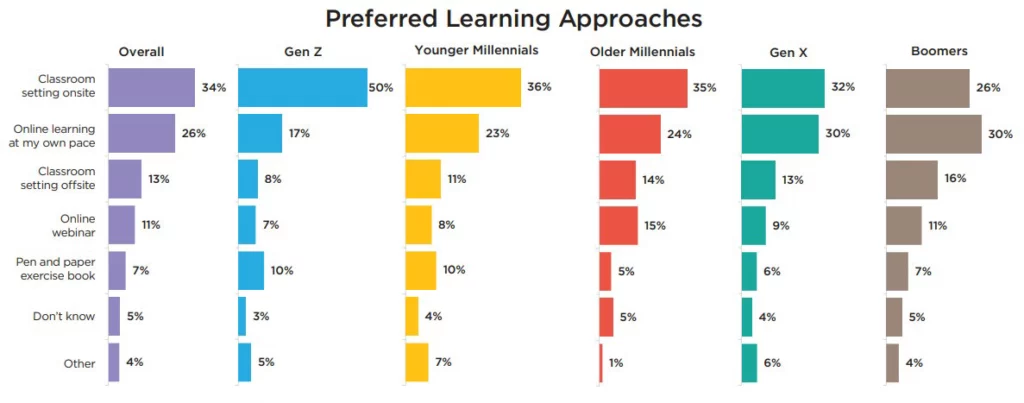
The opportunity to learn different jobs, however, is significantly more appealing to Generation Z (82%).
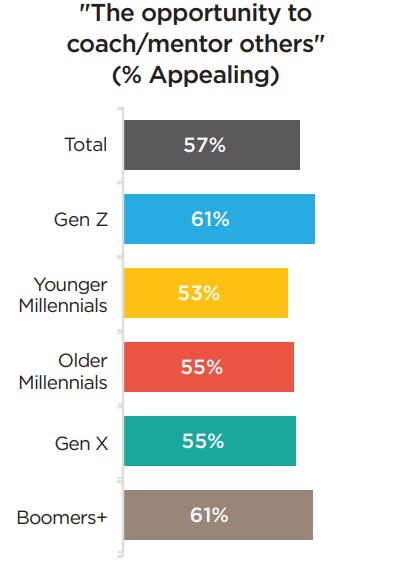
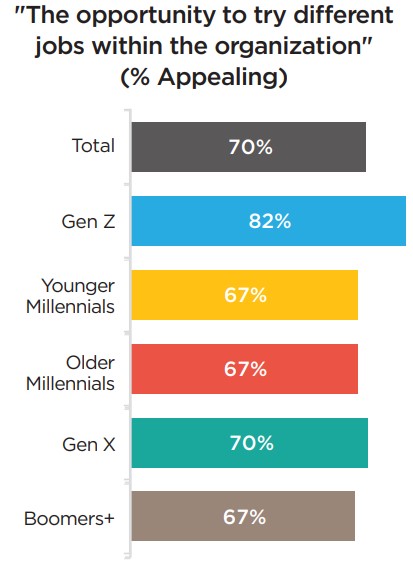
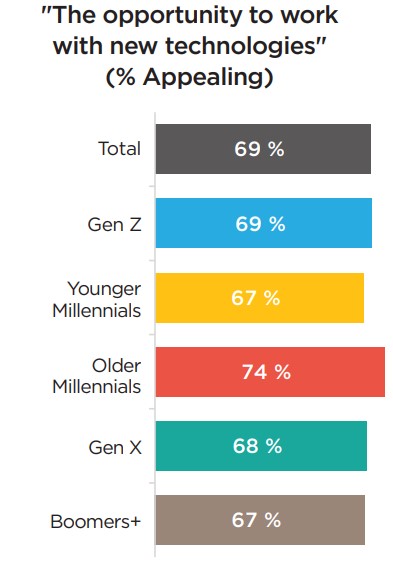
Q: First, for you personally, how important are each of the following career goals? Base: All Respondents, n=1,500
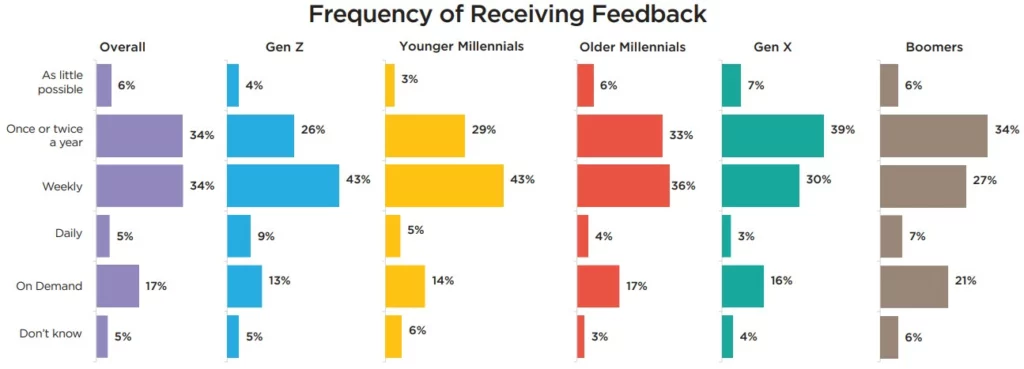
About one-third (34%) of the workforce would like to have feedback on a weekly basis.
As noted in the introduction, the objective of the study is to provide employers with practical information and guidance to help them more easily attract and retain employees. Below perceptions of manufacturing jobs is discussed, including in the food and beverage processing sector.
Consistent with past research, working in food and beverage manufacturing has moderate appeal – much less than working in government, banking/finance and information technology, somewhat more than auto manufacturing, and on par with the hotel/restaurant industry, retail, social media, construction.
The auto industry’s relative lack of appeal may be surprising given that wages in this sector have tended to be higher compared to other types of manufacturing, including food and beverage processing.10
A few noteworthy generational differences in the data. First, and as could be expected, working in social media holds significantly more appeal to Generation Z (41%), and least among Boomers (19%). More interesting is how relatively unappealing construction appears to Generation Z (i.e., only 13% would consider working in it). This result is instructive, given that this sector is a main source of competition for workers in the food and beverage manufacturing sector.
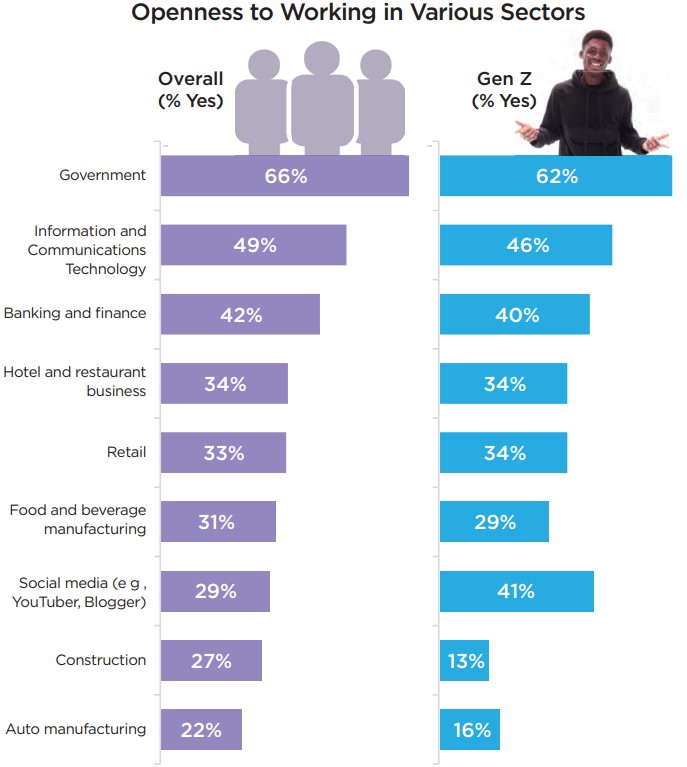
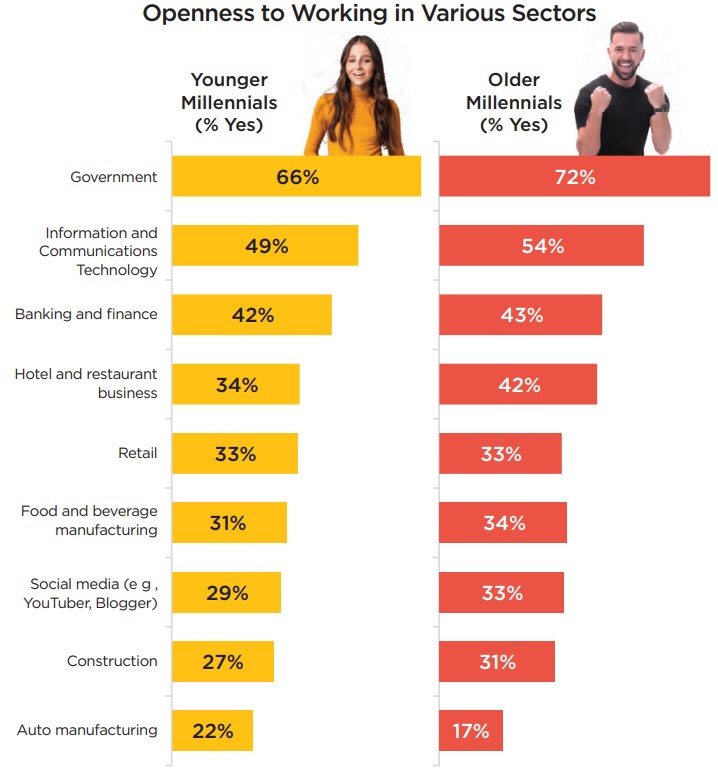
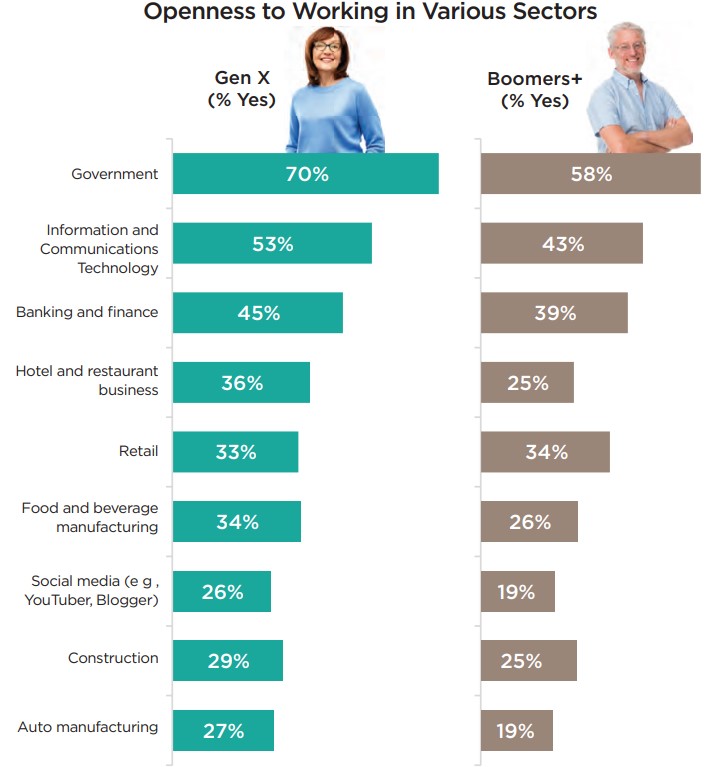
Q. Would you consider working in any of the following sectors? Base: All Respondents, n=1,500
The survey included two experiments whereby the sample was split into three to randomly test the relative impact of 1) job advertisement content (discussed later), and 2) use of the words: “factory”, “plant” and “workshop”. Both experiments were aimed at helping employers more effectively engage with potential employees.
Overall, the least appealing word is “factory”, followed by “plant”, with the differences being significant. Close to half (44%) agree with the statement: “I would never work in a factory.” The proportion agreeing falls to 37% when the statement contains the word “plant”, and then to 28% when “workshop” is substituted.
Generation Z results are very interesting. For this group, the word “plant” has, by far, the most negative connotation (65% say they would never work in one). This compares to 55% who say they would never work in a “factory” and only 35% who would never work in a “workshop”. It’s also worth noting that Young Millennials also seem to have a relative aversion to the word “plant”, but it is less pronounced.


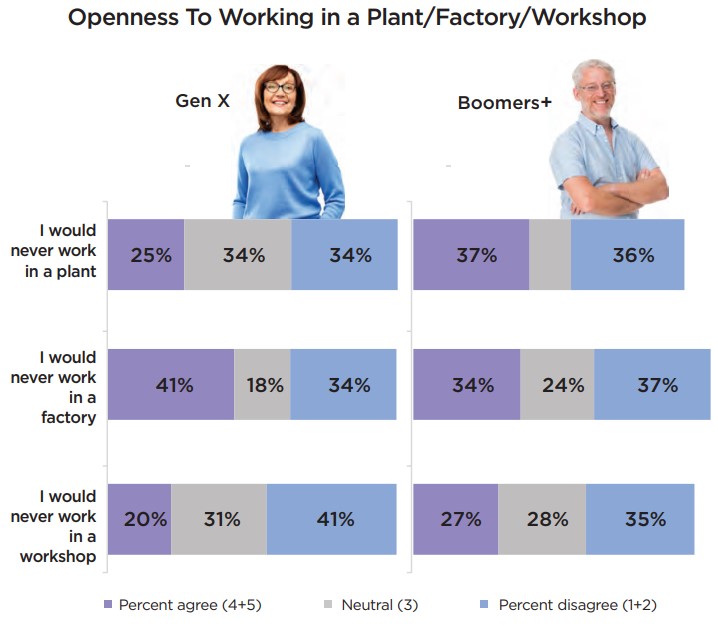
Q. Please indicate whether you agree or disagree with each of the following statements: Base: All Respondents, n=1,500
In its 2019 Trends Manufacturing Report Microsoft Dynamics 365 heralded “smart manufacturing” as “Fourth Industrial Revolution, describing it as:
“… a new generation of sophisticated technologies … transforming manufacturing into a highly connected, intelligent, and ultimately, more productive industry. The man-powered shop floor of the past is being replaced by smart manufacturing facilities where tech-savvy workers, aided by intelligent robots, are creating the products of the future.”
The study explored whether members of the labour force would consider working in “smart manufacturing” as a production worker? The following description accompanied the question:
“Smart manufacturing’ employs computer-integrated manufacturing, high levels of adaptability and rapid design changes, digital information technology, and more flexible technical workforce training.”
Close to two-thirds say either yes or maybe to working in smart manufacturing. Only 29% say no, while 11% don’t know. Views are generally consistent across generation, with the minor exception that Gen X (23%) are least likely to say no.

Q: Would you consider working in “smart manufacturing”? Base: All Respondents, n=1,500
For decades now, business, elected officials and educators have lamented Canada’s skills shortage. In its 2002 report, Solving the Skills Shortage, The Conference Board of Canada admonished: “Many years of effectively treating the skilled trades as a secondary career path has had the consequence of diminishing the status of these trades in the eyes of many youth.” Since then, and indeed for many years before, governments in partnership with others have tried to encourage young people to consider a career in the trades.
This study suggest that many young people continue to undervalue the trades. Specifically, the younger one is, the less likely they are to hold positive views of the trades, with Boomers at the positive end and Generation Z at the negative.
For example, 72% of Boomers agree that the trades pay well, compared to only 48% of Generation Z. The fact that 60% of Young Millennials agreeing suggests that a few years in the labour force enhances one’s valuation of a career in the trades.
Only 34% of Generation Z agree that a person with a trade will always have a job, compared to 55% of Gen X and 59% of Boomers. Similarly, only about half of Generation Z (52%) say they would be proud to tell someone to work in a trade, with the proportion rising with age to 72% of Boomers.
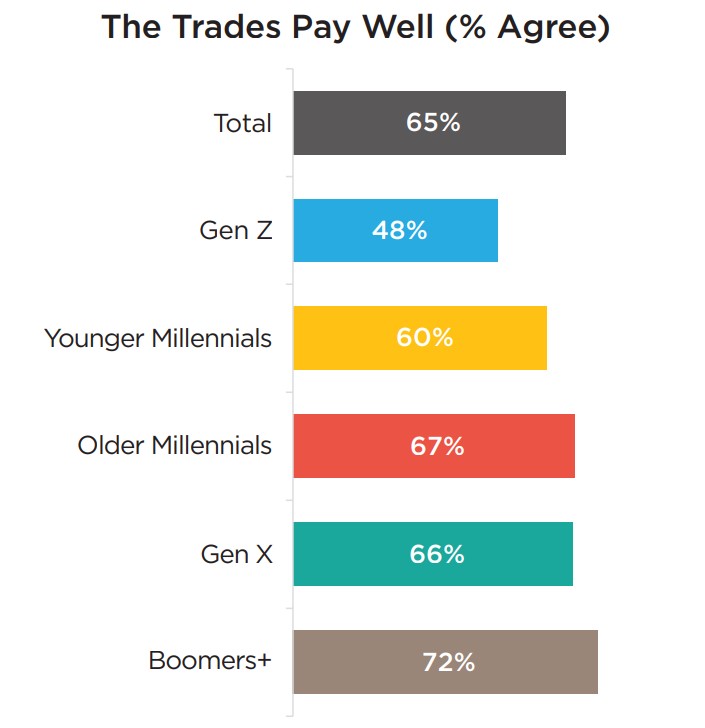
Q: Please indicate whether you agree or disagree with each of the following statements: Base: All Respondents, n=1,500
Perhaps the salient workplace trend over the past decade has been the improvement of physical environments to encourage employee health and wellness.
Tony Schwartz, writing in the Harvard Business Review Blog, has found that the promotion of employee physical, emotional and social well-being increases employee energy, focus and sense of purpose. Research by consultants Willis Towers Watson finds that a growing number of employers are defining integrated workplace health as a central part of company culture and strategy. Reshaping the physical environment to encourage healthy behavior includes adding healthy foods to breakrooms and restaurant delivery menus, ergonomic workstations, and appropriate lighting.
While the literature often links employer emphasis on employee health and wellness to productivity gains, this study examined this issue through the lens of employee recruitment and retention. The core question measured the attractiveness of 14 options related to compensation, benefits, workplace health and wellness and workplace flexibility.
Overall, the four most appealing options are traditional ones: standard health and dental coverage (appealing to 89%), personal performance bonuses (78%), the setting of one’s own hours and schedule (76%), and free parking onsite (75%). The appeal of these options is consistent across generations.
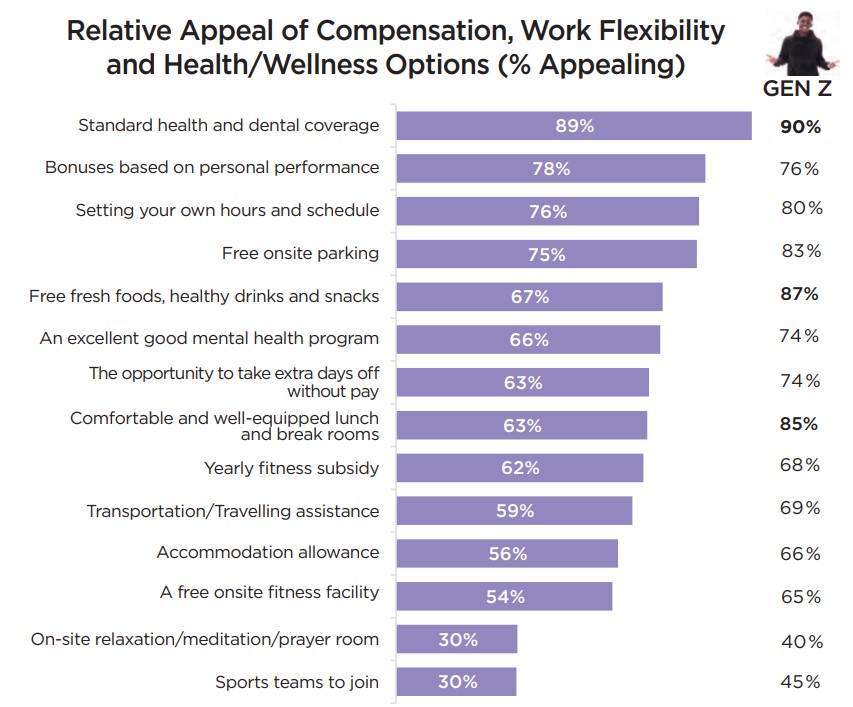
Q. If you were looking for a job, how appealing would you find each of the following: Base: All Respondents, n=1,500
A second tier of appealing options includes: free fresh foods, healthy drinks and snacks (67%), an excellent mental health program (66%), comfortable and wellequipped lunch and break rooms (63%), the opportunity to take extra days off without pay (e.g., taking every Friday off in the summer; 63%), and a yearly fitness subsidy (e.g., to pay for membership, sports equipment, fitness classes; 62%).
There are many significant differences in the appeal of options across the health and wellness options, including those aimed at promoting social solidarity. Essentially, the younger one is, the more appeal these options hold. The most striking results are found in the Generation Z responses, whose top three choices are: standard health and dental coverage (appealing to 89%), free fresh foods, healthy drinks and snacks (87%), and comfortable and well-equipped lunch and break rooms (85%).
This segment is also much more likely to value a free onsite fitness facility (65% compared to an average labour market result of 54%) and sports teams to join (e.g., softball, bowling, volleyball, broomball; 45% compared to an average of 30%).
Young Millennials also tend to place a higher value on the health and wellness/ social options, but not to the same extent as their juniors.
The final section of the questionnaire was devoted to an experiment to test the relative appeal of employment opportunities that offered A) flexible work arrangements and B) progressive/health and wellness options. The results of the experiment suggest that employers who offer such arrangement and options are more likely to attract recruits.
As with the first experiment (discussed earlier in this report) the sample was randomly divided into three:
Each third was asked to consider two food and beverage manufacturing employment postings: one for a laboring position and another for a food scientist (see the tables on the following pages for the text of the six job postings).
The versions of the job ads were identical, except that the “flexible” and “progressive” versions included information not found in the “control” version.

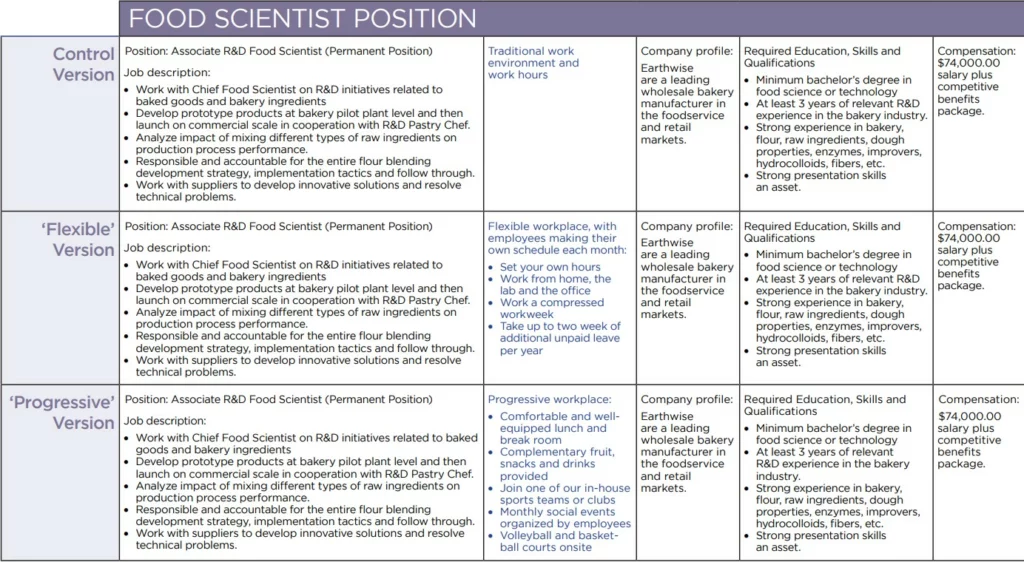
Respondents were asked two questions: 1) How likely would you be to share the following job listing with someone who is qualified for this type of work? 2) Thinking about yourself, how interested would you be in that job?
The results of the experiment are that respondents were more likely to recommend the Flexible and Progressive version of the labourer job ad than the control version. There were no differences, however, with respect to recommending the food scientist job posting.
Responses are consistent across generations.

The personal interest ratings for the laborer position are consistent across the three versions. Interest in the position of food scientist, however, is slightly higher in response to the “flexible” and “progressive” versions of the posting.
Once again, responses are consistent across generations.

The responses were consistent across all generations when it came to recommending the food scientist job posting.
The food and beverage manufacturing sector includes many seasonal operations. More broadly, there is a continued proliferation of contract and part-time across the economy. For many workers, anything less than a full-time permanent job is second best, while for some, the flexibility of so-called “gig” work arrangements is advantageous, if not ideal.
Overall, the study finds that large segments of the workforce are open to working part-time (45%), contract work (44%), and seasonal employment (32%). The most open to these work arrangements are Boomers, of whom 63% are open to working part-time and 54% would consider contract work.
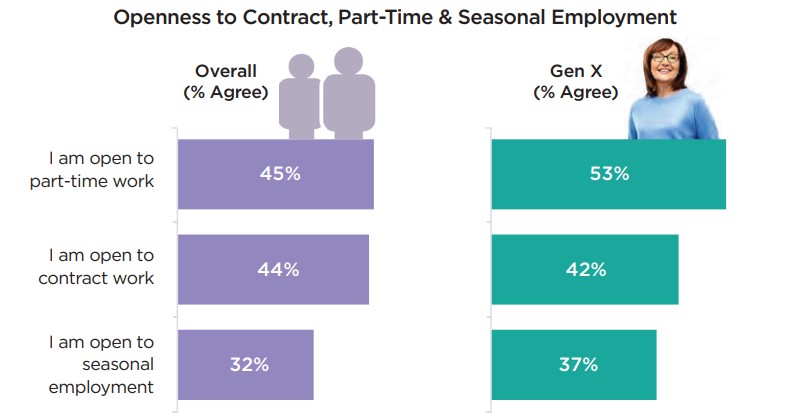
Q: Please indicate whether you agree or disagree with each of the following statements: Base: All Respondents, n=1,500
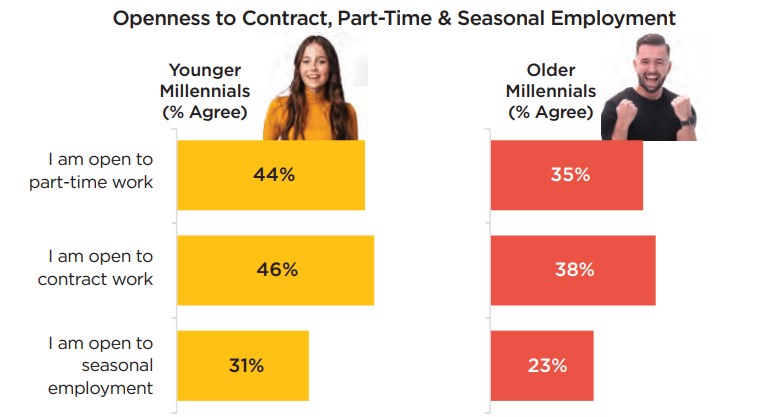
Q: Please indicate whether you agree or disagree with each of the following statements: Base: All Respondents, n=1,500
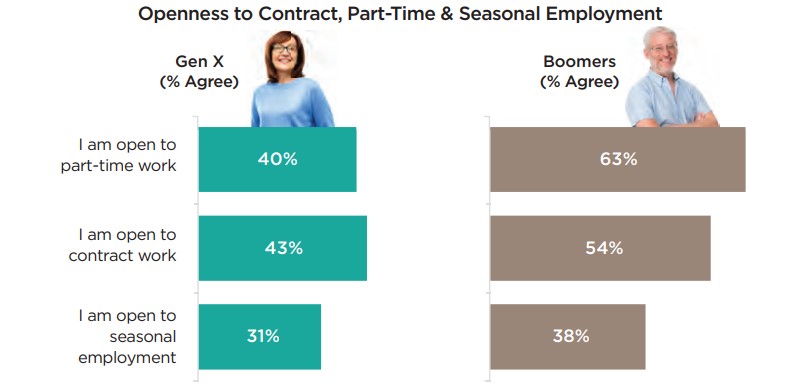
Q: Please indicate whether you agree or disagree with each of the following statements: Base: All Respondents, n=1,500
According to Statistics Canada, the rate of unionization fell from 37.6% in 1981 to 28.8% in 2014, with decline steepest in the private sector and among young men.11 Much has been written about the decline in union membership in North America, including its link to the shrinkage of the manufacturing sector and the concomitant growth of traditionally non-unionized jobs (e.g., in-services and hospitality). In addition, some argue that trade unions are much less relevant in the eyes of younger workers.12
This study shows that while overall perceptions of unions are divided (i.e., 38% agree that “unions are a good thing” and 24% disagree), younger people are actually less likely to have a negative perception of unions: 29% of Boomers and 30% of Gen-X disagree that unions are a good thing, compared to only 17% of Young Millennials and 12% of Generation Z.
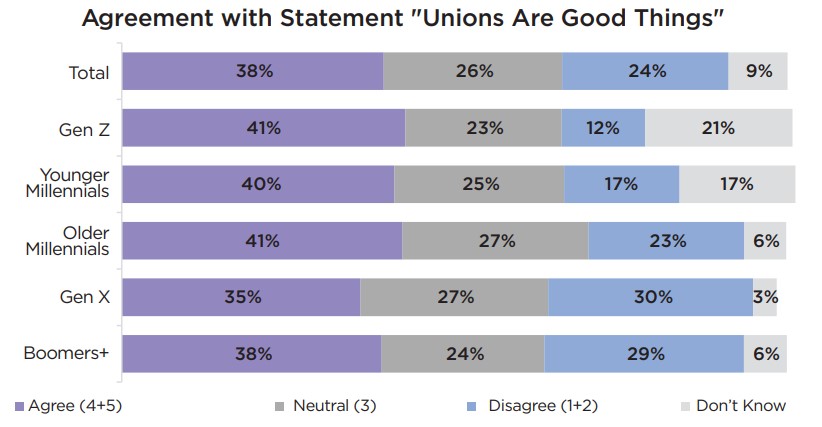
Q: Please indicate whether you agree or disagree with each of the following statements: Base: All Respondents, n=1,500
Younger people are actually less likely to have a negative perception of unions.
Women are not as open to working in manufacturing, either generally or specifically with respect to food and beverage. The terminology used to describe the setting (e.g., in a job posting) can also make a difference – the word “plant” (as opposed to “factory” or “workshop”) seems to have particularly negative connotations for women as compared to men.
This study suggests that among the items tested women and men have similar career goals and motivation, but women are more likely to place importance on managing their work-life balance and on making a positive impact on society. Similarly, they are more likely than men to place importance on working for an organization that shares their values
While both women and men are equally concerned about most work-related issues tested in this study, such as making enough money to support themselves and their family, women express a significantly greater degree of concern about getting burned-out and balancing work and a healthy lifestyle.
This study suggests women are less likely than men to ascribe to the generational stereotypes that “younger workers are unrealistic about advancement” and “older workers only care about money”.
The relative appeal of the various potential compensation, work flexibility and health/wellness options examined in the survey is similar for women and men, with a few notable exceptions. Consistent with their higher level of worry about burnout and balancing work and a healthy lifestyle, a workplace that provides fresh foods, healthy drinks and snacks and/or one that offers an excellent mental health program is significantly more appealing to women. In contrast, having sports teams to join has significantly less appeal to them.
This study suggests that women are more likely to place importance on managing their work-life balance and on making a positive impact on society.
It is also worth noting that this study suggests women are more open to trade unions, with only 17% disagreeing that “unions are a good thing” compared to 31% of men.
Perhaps the most interesting gender difference in the study is found in the job description experiment, with respect to the labourer position. The position becomes significantly more attractive (i.e., would recommend to a friend they believed was qualified) among women when it includes flexible work arrangements (i.e., the flexible version of the job posting) or progressive/health and wellness programs (i.e., the progressive version). In contrast, men are unmoved.

Notwithstanding the above results, the labourer job is significantly more personally interesting to men (29% say they are interested in it) than to women (20%). The appeal of the food scientist position did not vary overall or by gender across the control and two treatment versions. Like the labourer job, the food scientist position is also more personally interesting to men (38%) than women (27%).
61% of women compared to 49% of men worry about being overworked/ getting burned-out.
There are relatively few regional differences in the data, with the exception of Quebec.
Quebecers are notably different when it comes to
career goals, aspirations and concerns, and with
respect to their lack of openness to working in food
and beverage manufacturing. It is important to note,
however, that the Quebec part of our sample has
a somewhat larger proportion of Generation Z in it
(14% compared to 9% in the rest of Canada sample).
Quebeckers’ career goals, aspirations and concerns tend to be more oriented to values (e.g., wanting to work for an organization that shares theirs), achieving work-life balance and the importance of the social aspects of work.
The survey suggests that Quebecers are much less open to working in food and beverage manufacturing than other Canadians. It is important to contextualize this result by noting that Quebecers are also less interested in working in the other eight sectors examined as part of the same question.
Quebecers are more likely than other Canadians to view the terms “plant” (usine de production) and “factory” (usine the fabrication) as having a negative connotation. Not so with the term “workshop” (atelier), however.
Quebecers are also less interested in working in “smart manufacturing”.
Compared to other Canadians, Quebecers have a less positive view of the trades, while the opinion of unions is consistent across the country.
Quebecers and other Canadians have similar views and preferences regarding the appeal of compensation, work flexibility and health/wellness options. The study does reveal, however, that Quebecers find personal performance bonuses less appealing.
They are also less open to part-time and seasonal work, but more open to having a supervisor who is younger than they are or from an older generation.
Quebecers are notably different when it comes to career goals, aspirations and concerns, and their lack of openness to working in food and beverage manufacturing.
As noted in the introduction of this report, the aim of this study is to help organizations attract and retain workers. This report endeavors to provide practical advice without appearing presumptuous or unrealistic. The food and beverage manufacturing sector is incredibly diverse, and it is out of respect for this diversity that employers, as well as other stakeholders, are encouraged to reflect on the considerations and questions outlined below.
When attracting and retaining younger people and women, Is it possible to avoid words such as “plant” and “factory”?
Consider providing information on the “big picture” issues such as corporate plans, goals, success, challenges, and performance.
NOTE: The Appendices for this publication are available in electronic format upon request. Please contact Food Processing Skills Canada (FPSC) by email or phone.